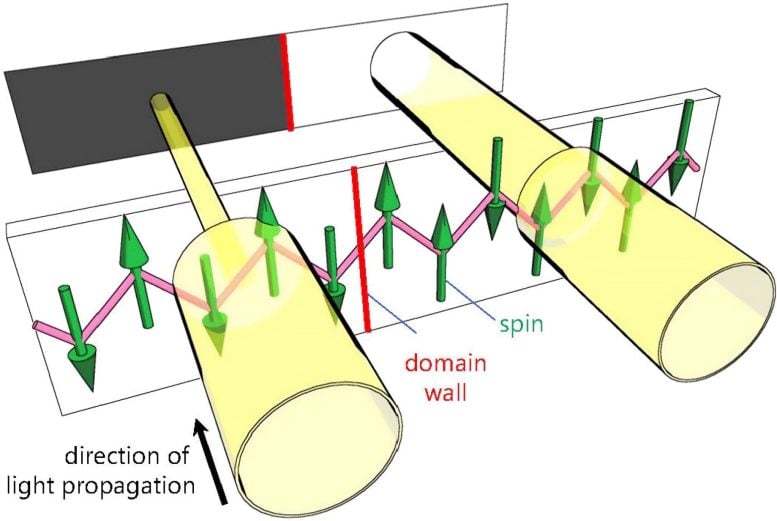

Scientists have made significant strides in visualizing and manipulating tiny magnetic regions in quantum materials using light.
This breakthrough not only deepens understanding of magnetic materials at the quantum level but also advances the development of next-generation electronics and memory devices by exploring antiferromagnets, which exhibit unique properties that make them ideal for such applications.
Quantum Magnetism
When something draws us in like a magnet, we take a closer look. When magnets draw in physicists, they take a quantum look.
Researchers from Osaka Metropolitan University and the University of Tokyo have made strides in using light to both visualize and manipulate small magnetic regions called magnetic domains in a quantum material. By applying an electric field, they were able to control these domains, enhancing our understanding of magnetic materials at the quantum level, and paving the way for future technological advances.
While many of us are familiar with the magnets that cling to metal surfaces, there are other types, like antiferromagnets, that don’t. These have garnered significant interest from technology developers around the world.
Challenges in Studying Quantum Antiferromagnets
Antiferromagnets are magnetic materials in which magnetic forces, or spins, point in opposite directions, canceling each other out and resulting in no net magnetic field. Consequently, these materials neither have distinct north and south poles nor behave like traditional ferromagnets.
Antiferromagnets, especially those with quasi-one-dimensional quantum properties — meaning their magnetic characteristics are mainly confined to one-dimensional chains of atoms — are considered potential candidates for next-generation electronics and memory devices. However, the distinctiveness of antiferromagnetic materials does not lie only in their lack of attraction to metallic surfaces, and studying these promising yet challenging materials is not an easy task.
“Observing magnetic domains in quasi-one-dimensional quantum antiferromagnetic materials has been difficult due to their low magnetic transition temperatures and small magnetic moments,” said Kenta Kimura, an associate professor at Osaka Metropolitan University and lead author of the study.

New Techniques in Observing Quantum Materials
Magnetic domains are small regions within magnetic materials where the spins of atoms align in the same direction. The boundaries between these domains are called domain walls.
Since traditional observation methods proved ineffective, the research team took a creative look at the quasi-one-dimensional quantum antiferromagnet BaCu2Si2O7. They took advantage of nonreciprocal directional dichroism — a phenomenon where the light absorption of a material changes upon the reversal of the direction of light or its magnetic moments. This allowed them to visualize magnetic domains within BaCu2Si2O7, revealing that opposite domains coexist within a single crystal, and that their domain walls primarily aligned along specific atomic chains, or spin chains.
Visualizing and Manipulating Quantum Domains
“Seeing is believing and understanding starts with direct observation,” Kimura said. “I’m thrilled we could visualize the magnetic domains of these quantum antiferromagnets using a simple optical microscope.”
The team also demonstrated that these domain walls can be moved using an electric field, thanks to a phenomenon called magnetoelectric coupling, where magnetic and electric properties are interconnected. Even when moving, the domain walls maintained their original direction.
“This optical microscopy method is straightforward and fast, potentially allowing real-time visualization of moving domain walls in the future,” Kimura said.
Implications for Future Quantum Technologies
This study marks a significant step forward in understanding and manipulating quantum materials, opening up new possibilities for technological applications and exploring new frontiers in physics that could lead to the development of future quantum devices and materials.
“Applying this observation method to various quasi-one-dimensional quantum antiferromagnets could provide new insights into how quantum fluctuations affect the formation and movement of magnetic domains, aiding in the design of next-generation electronics using antiferromagnetic materials,” Kimura said.
Their study was published in Physical Review Letters.
Reference: “Imaging and Control of Magnetic Domains in a Quasi-One-Dimensional Quantum Antiferromagnet BaCu2Si2O7” by Masato Moromizato, Takeshi Miyake, Takatsugu Masuda, Tsuyoshi Kimura and Kenta Kimura, 22 August 2024, Physical Review Letters.
DOI: 10.1103/PhysRevLett.133.086701